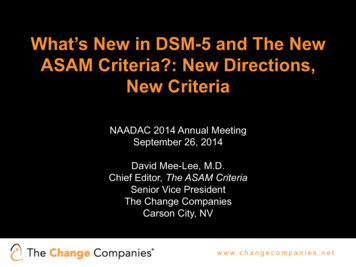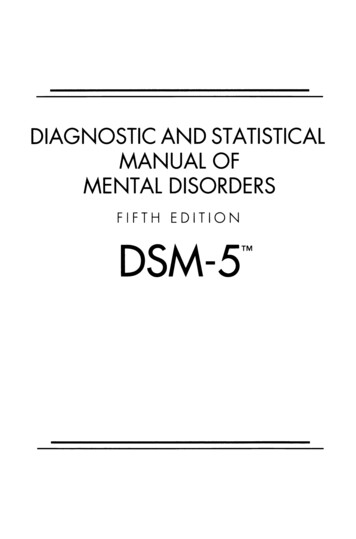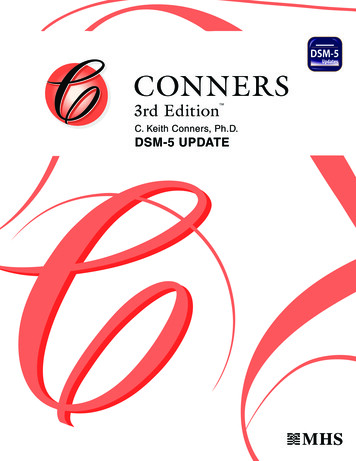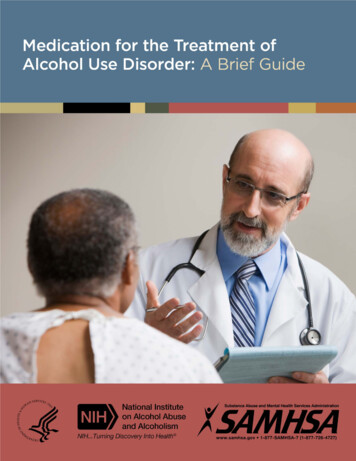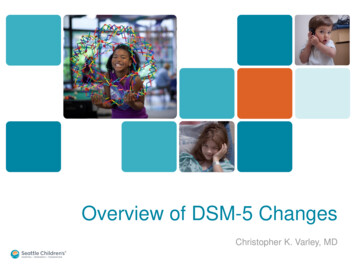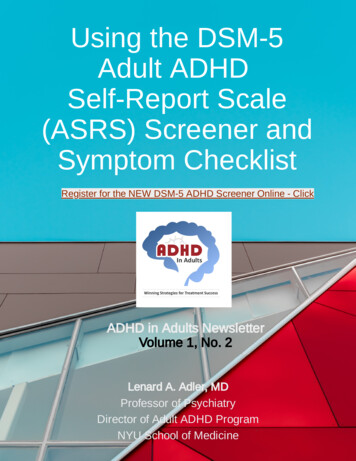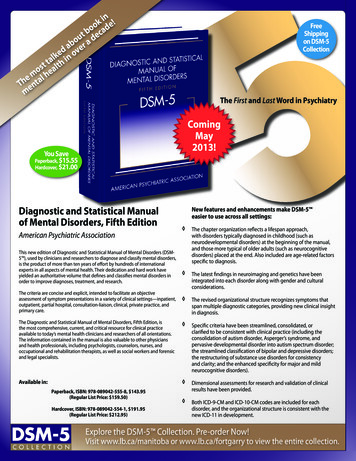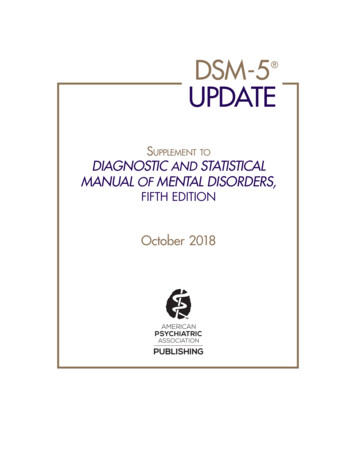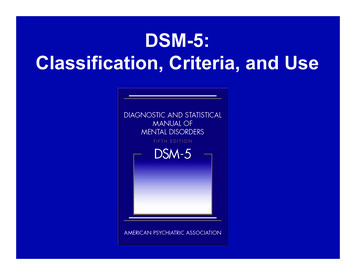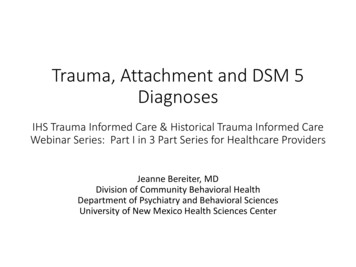
Transcription
Trauma, Attachment and DSM 5DiagnosesIHS Trauma Informed Care & Historical Trauma Informed CareWebinar Series: Part I in 3 Part Series for Healthcare ProvidersJeanne Bereiter, MDDivision of Community Behavioral HealthDepartment of Psychiatry and Behavioral SciencesUniversity of New Mexico Health Sciences Center
Introduction IHS has partnered with the University of New Mexico School of MedicineDivision of Community Behavioral Health to Present an integrated approach to Historical Trauma, Trauma, and TraumaInformed Care in health and behavioral health settings Rollout of: A series of webinars Monthly case consultations Today’s webinar is Part II in a 3 part series for healthcare providers
Objectives As a result of having participated in this webinar, participantswill be able to: Identify how childhood trauma and attachment problems can lead topsychiatric diagnoses and adverse health behaviors. Summarize the clinical characteristics of acute stress disorder, PTSD, andcomplex PTSD and appropriate clinical management of these disorders. Describe trauma specific treatments and indications for patient referralfor these treatments
Polling Question What is your primary professional affiliation?1.MD/DO, Nurse practitioner, Physicians Assistant2.Nurse3.Medical assistant4.Psychiatrist5.Psychologist6.Social worker (LCSW, LISW)7.Other therapist (LPCC, etc.)8.Supervisor/administrator9.Front Desk Staff10. Community health representative11. Peer support worker
Trauma & attachment
What Is Trauma?“trauma results from an event, series of events, or set ofcircumstances that is experienced by an individual asphysically or emotionally harmful or threatening and thathas lasting adverse effects on the individual’s functioningand physical, social, emotional, or spiritual well-being”Substance Abuse and Mental Health Services Administration. Trauma-Informed Care in Behavioral Health Services. Treatment Improvement Protocol (TIP)Series 57. HHS Publication No. (SMA) 13-4801.
Types of Trauma Single event E.g. being in a car crash, natural disaster, sexual assault, medicalprocedure Multiple events, over time E.g. incest, war, racism, micro-aggressions, multiple medicalprocedures Can lead to Complex Trauma Vicarious or secondary trauma Multigenerational including historical trauma
Caveats What is traumatic to 1 person may not be to another Trauma affects a person’s neurobiology in ways that are longlasting or permanent Trauma can lead to adverse health outcomes PTSD Not everyone who has experienced trauma develops PTSD oradverse health outcomes Cumulative trauma has cumulative effects There are effective treatments for traumaCreating Cultures of Trauma Informed Care (CCTIC)
Culture and TraumaCulture determines acceptable responses to trauma andshapes the expression of distress Culture affects what qualifies as a legitimate healthconcern and which symptoms warrant helpCulture can provide a source of strength, unique copingstrategies, and specific resources.Cultural assessment is essential for appropriate diagnosis andcare
Historical Trauma and Unresolved Grief Historical trauma - Cumulative emotional and psychologicalwounding from massive group trauma across generations, includinglifespan Historical trauma response (HTR) is a constellation of features inreaction to massive group trauma, includes historical unresolvedgrief (similar to Child of Survivors Complex re: Jewish Holocaustsurvivors and descendants, Japanese American internment campsurvivors and descendants), depression, PTSD(Brave Heart, 1998, 1999, 2000)
Healthy and Toxic Stress Healthy stress Stress is a normal part of life, part of healthy development Helps us to grow and change Moderate degree, short lived, E.g. meeting new people, taking a newjob Occurs in the context of stable, supportive relationships Toxic stress Level or chronicity of stress that overwhelms coping systems (bothbiological and supportive relationships)
Acute Stress Our bodies are designed to deal with acute stress Fight/flight/freeze reaction is initiated This stress response system increases our ability to survivedanger Once stress is over systems return to normal (homeostasis) vianegative feedback loops
Defense Cascade:Fight, Flight, or Freeze
Freeze Response Attentive immobility Usually lasts for only a few seconds Allows person to assess the danger and decide whether to fight or flee Often begins with freeze (assess the situation, hide from predator, thenrespond) Includes opioid-mediated analgesia, lower HR Increased occurrence in people with trauma histories when person isexposed to a cue associated with a previously negative event Can lead to immobility, dissociation
Dissociation Our mind’s “safety valve” When overstimulated, we shut down, or dissociate thoughtsfrom feelings/body from thoughts Can manifest as: Fainting Emotional numbing Amnesia Conversion into physical symptoms Fragmentation of sense of self Can lead to dissociative disorders (DSM 5)
Chronic Stress Chronic stress Our bodies are not designed to deal with stress that doesn’t go away Same systems are activated as in acute stress, but are activated over andover This has adverse effects Initial high levels of cortisol then blunted corticosteroid release Brain changes (high levels of cortisol are toxic) Impairs neural plasticity, damages the hippocampus which impairs memory Epigenetic changes These adverse effects lead to increased risk of physical andpsychiatric illness
Normal Brain Development The brain isn’t structurally complete at birth It is designed to develop based upon cues from theenvironment Brain growth requires Interaction with loving, predictable people A healthy physical environment Children haven’t yet developed fully the ability to regulatearousal They require help from adultshttps://www.aap.org/en-us/Documents/ttb aces consequences.pdf
Sensitive Periods for Attachment & NormalInfant Development Language 15 months Attachment 24 months
How Trauma Interferes With Normal BrainDevelopment Trauma interferes with normal biological maturation Adversely effects neurodevelopment Structurally Neuroendocrine systems Immune system Epigenetics Traumatized parents often have difficulty helping theirchildren’s brain developmenthttps://www.aap.org/en-us/Documents/ttb aces consequences.pdf
Clinical Effects Of Stress Induced NeurobiologicalChanges Decreased ability to put experience into words Problems with declarative memory Decreased ability to think through a situation Especially when emotionally aroused problems with executive functioning Memory problems Difficulty with time frame Difficulty sequencing (what came first, when, what came next)
This Leads To People with trauma histories may experience strongemotions, sounds, smells, impressions (often nonverbal) This combines with Decreased ability to problem solve Difficulty with time sequencing Can result in emotional outbursts
Overarousal and Underarousal Hypervigilance or underarousal are adaptive in times of danger Fight, flight, or freeze These same behaviors are maladaptive in school, work, medicalsettings Overreactions Triggered by sights, smells, tone of voice Lack of reaction/passivity
Prevention of Trauma/Trauma Responses Adequate nurturing/attachment in childhood Adequate social support in adulthood
Attachment
Attachment Social contact is as necessary to our survival as food and water Failure to thrive in orphanages, can lead to death Babies are dependent upon their caregivers They develop attachment to their primary caregivers—other adults won’tdo (Stranger anxiety at 6-9 months) They develop attachment to caregivers even if the caregiving is abusive orneglectful With loss of caregiver child protests, then falls into despair Eventually, child loses interest in attachment (see RAD) Lack of attachment figures is a type of trauma
Harry Harlow and Monkey Experiments
Attachment-continued Attachment between child and caregiver makes child feelsafe, secure, protected Primary attachment figures help regulate the infant’s brain Infant learns through attachment figure(s) how to selfsoothe, recognize emotions Without good attachment, infant is at higher risk ofpsychological problems, abnormal brain development Attachment protects against social and emotionalmaladjustment
Mirror Neurons Network of neurons in the brain Our neurons fire when performingand behavior and when observingthe same behavior in others We understand the other’sintention This allows us to imitate behavior,and understand what others feel
Theory of Mind The ability to understand that we have mental states(beliefs, intents, desires) and that others have mental statesdifferent from our own Thought to begin around age 4
Mary Ainsworth and The Strange Situation Mary Ainsworth was a developmental psychologist who helpedto develop attachment theory “Strange Situation” is a laboratory procedure to studyattachment in children age 10 months-5 years Evaluates how much infant/child explores Reaction to caregiver’s absences/return
Types of Attachment-Secure Secure 55%-60% general population Caregiver consistently responds to distress in sensitive, responsiveways Infant goes to caregiver for soothing, also able to play/explore Infant sees caregiver as caring and loving, and self as worthy As child grows, they are more able to get along with peers, handleconflict
Types of Attachment-Insecure/Avoidant Insecure/Avoidant 23% Caregiver is rejecting of infant’s needs/non-responsive Infant doesn’t go to caregiver for soothing Infant learns to deal with distress by itself, be independent
Types of Attachment-continued Insecure/ Resistant 8% Caregiver responds in inconsistent manner, or needs infant to respondto her own needs Infant has trouble being soothed by caregiver, can be angry/rejecting Disorganized Caregiver responds in frightening/atypical ways Infant behaves in contradictory ways e.g. fear of caregiver, freezing Nearly 80% of maltreated children have this attachment style
Repairing Ruptures There are always ruptures in attachment The important thing is to repair them Repair acknowledges the rupture, and attempts toreconnect
Failure to Thrive
Attachment Can be Improved Via enriched environment Attentive caregiver E.g. Bucharest Early Intervention Project Prior to the study 65% of institutionalized children had disorganizedattachment, 13% had no attachment At 42 months 49% of children in foster care had secure attachmentsversus 18% in institutionalized group versus 65% living with their parents Decrease in RAD and improvement in cognitive functioning found as wellNelson et al; 2009
Adult Attachment is Important Attachment status of the parent can be evaluated Adult attachment interview If parent is securely attached, infant is likely to be securelyattached If parent is insecurely attached, infant is likely to beinsecurely attached
DSM 5- Trauma and Stressor Related Disorders Trauma and Stressor Related Disorders (across the lifespan) Reactive Attachment Disorder Disinhibited Social Engagement Disorder Posttraumatic Stress Disorder Acute Stress Disorder Adjustment Disorders
Trauma and Stressor Related Disorders Disorders listed in DSM 5 in which exposure to a traumatic orstressful event is an explicit diagnostic criterion Other psychiatric conditions are often associated withexposure to a trauma or stressful event Dissociative disorders Anxiety disorders Depression
Reactive Attachment Disorder (RAD) andDisinhibited Social Engagement Disorder Absence of adequate caregiving (social neglect) during childhood is adiagnostic criterion Neglect is emotional, interferes with attachment Neglect may also be physical Neglect can be due to Repeated changes in primary caregiver e.g., foster care Rearing in an institutional setting e.g., orphanage Emotional unavailability of primary caregiver e.g., maternal depression orsubstance use
Difference between RAD and DSED In RAD child is emotionally withdrawn, may be depressed May appear unattached In DSED, child is indiscriminately social, indiscriminatelyattached same behavior to adults child barely knows as to caregivers
Posttraumatic Stress Disorder Involves exposure to “actual or threatened death, serious injury,or sexual violence in one (or more) of the following ways” Direct experience Witnessing the event occur to others Learning that the event occurred to a family member or friend Experiencing “repeated or extreme” exposure to details of the traumaticevents (can include occupational exposure e.g., first responders)
PTSD Diagnostic Criteria-continued Presence of symptoms in different domains: intrusion avoidance negative cognition or mood change in arousal and reactivity Lasts for more than 1 month Onset usually within 3 months after trauma but can bedelayed
PTSD-Intrusion Symptoms Recurrent, involuntary, and distressing memories of the trauma Distressing dreams (nightmares) related to the trauma Dissociative reactions (flashbacks) in which it feels as if the trauma isrecurring Psychological distress when exposed to cues of the trauma Physiological reactions to cues of the trauma In children 6 may manifest as play reenactment
PTSD-Avoidance Symptoms Avoidance of memories, thoughts, feelings of/about thetrauma Avoidance of external reminders of the trauma Activities Objects Situations
PTSD-Negative Alternations in Cognitions andMood Inability to remember an important aspect of the trauma Due to dissociative amnesia Negative beliefs about oneself, others, or the world “I am bad” “I can’t trust anyone” “the world is a dangerous place” Distorted cognitions about the cause or consequences of the event/blamesself or others Negative emotional state-shame, anger, guilt Diminished interest or participation in activities Feeling detached or estranged from others Inability to experience positive emotions
PTSD-Alterations in Arousal and Reactivity Irritable behavior, angry outbursts, aggression Reckless or self-destructive behavior Hypervigilance Exaggerated startle response Problems concentrating Sleep problems
Prevalence of PTSD in USA Lifetime risk for development of PTSD by age 75 is 8.7% Lower rates among children Lower rates among elderly Higher rates among veterans, occupational exposure Certain ethnicities have higher rates compared to non Hispanic white:AI/AN, Latinos, African Americans Lower rates among Asian Americans Survivors of rape, military combat and captivity, ethnically or politicallymotivated internment and genocide especially high rates of PTSD More than 1/3 to ½ of those exposed develop PTSD
PTSD in AI/AN Population AI/AN communities in general have higher risk of experiencing trauma thanany other ethnic group Twice as likely as general population to develop PTSD Higher levels of PTSD reflect higher exposure to trauma Related problems: body pain, lung disorders, general health problems,substance abuse, pathological gambling Most frequently implicated trauma is military combat 2nd most common is interpersonal violence Protective factors: Traditional non Christian religious practices Little research on effective treatmentsBassett et.al., 2014
Trauma Exposure in American Indian Men American Indian males have non-interpersonal trauma exposure rates of25.2% in SW and 36.4% in NP, including natural disasters, life-threateningaccidents (Manson, et al., 2005) Interpersonal trauma exposure rates (assault, rape, abuse, combat) –25.5% in SW and 31% in NP for Native men Witness to trauma – 46.7% SW & 46.3% NP Many Native military and veterans may be wakiksuyapi, carrying bothhistorical trauma and modern combat trauma
Complex Trauma Sometimes also referred to as Complex developmental trauma or developmental trauma disorder (ifin children) Complex PTSD Disorders of extreme stress Found in people who have experienced multiple, chronic orprolonged traumas
Complex Trauma Isn’t a DSM Diagnosis Not a DSM 5 diagnosis or a Condition for Further Study Is planned for inclusion in ICD-11 DSM IV field trial showed that 92% of people with complex PTSD alsomet diagnostic criteria for PTSD However, PTSD doesn’t cover the complexity of complextrauma Many researchers and clinicians see it as a valid, essentialdiagnosis
Complex Trauma-2 Often present with symptoms that don’t fit into DSM 5categories Dissociation, anger, depression, change in self concept, change inresponse to stressful events Dysregulation of multiple symptom domains Body-sensory andmotor Affect-explosive/irritable or frozen/restricted Cognition-flashbacks, dissociation, altered perceptions/beliefs Behavior-regression (in children)
Complex Trauma-3 There is no established standard for the assessment ofcomplex trauma in children Prolonged, repeated trauma may result in different oradditional symptoms and need for special attention Involves prolonged trauma in which the person was “in a state ofcaptivity” physically or emotionally (Herman, J. (1997). May result in personality disorder diagnosis (e.g. borderline PD) ormultiple other diagnoses (bipolar, ADHD, conduct disorder) Treatment involves need for person to regain sense of control andpower, and work in interpersonal relationships
Complex PTSD Symptoms Interpersonal problems Negative self-concept Interpersonal sensitivity Affect dysregulation Increased risk of self-injury and repeated victimization
Acute Stress Disorder Involves exposure to a trauma as in PTSD Involves intrusion symptoms, negative mood, dissociativesymptoms, avoidance symptoms, and arousal symptoms Lasts for 3 days to 30 days If lasts for more than a month, diagnose PTSD
Adjustment Disorders Involve development of emotional or behavioral symptoms inresponse to an identifiable stressor Different types based upon predominant problems: Anxiety depression behavioral disturbance Occur within 3 months of onset of the stressor Resolve within 6 months of resolution of the stressor
Dissociative Disorders Loss of continuity of subjective experience Inability to control normal mental functions such asmemory—amnesia Often but not always associated with trauma Both Acute Stress Disorder and PTSD include dissociativesymptoms
Types of Dissociative Disorders Dissociative Identity Disorder Previously known as multiple personality disorder Disruption of identity into 2 or more personality states Dissociative Amnesia Inability to recall important autobiographical information Depersonalization/Derealization Disorder Depersonalization: feelings of unreality, detachment, being an outsideobserver of oneself, not feeling feelings Derealization: surroundings seem unreal, in a fog
Treatment of Trauma Make systems trauma informed Corrective emotional experiences Therapeutic relationship Increase social support Trauma specific treatments
Trauma-Specific Treatments Trauma focused cognitive behavioral therapy (CBT) Dialectical Behavioral Therapy (DBT) Eye movement desensitization and reprocessing (EMDR) Tapping Prolonged Exposure (PE) Treatment for historical trauma e.g. HTUG Psychodynamic therapy Pharmacotherapy Traditional healing
Trauma-Specific Treatments-continued Body therapies “sensorimotor” Breathing techniques Acupuncture Exercise Rhythmic activities- drumming, dancing Mindfulness meditation Massage Neurosequential model of therapeutics Hakomi therapy Equine therapy
Prolonged Exposure Therapy (PE) Evidence based, manualized treatment for PTSD Reduces symptoms of PTSD, depression, anger, and anxiety,and increases confidence/mastery Based on emotional processing theory Blocks avoidance Introduces corrective information Components: Psychoeducation,anxiety reduction techniques,develop list of avoided people, places, activityimaginal and in vivo exposure
Cognitive Processing Therapy (CPT) A form of cognitive behavioral therapy 12 sessions Involves cognitive restructuring Challenging cognitive distortions and assumptions
Trauma Focused CBT Evidence based treatment for children and adolescents and their caregivers Developed by Drs. A Mannarino, J Cohen, E Deblinger Structured Short term treatment (8-25 sessions) Can be used in children and youth even without PTSD diagnosis Involves psychoeducation, teaching stress management, affect expressionand modulation, cognitive coping, creating and sharing the traumanarrative, behavior management training, parent-child sessions Proprietary, requires official training
Dialectical Behavior Therapy (DBT) A type of cognitive behavioral treatment developed by MarshaLinehan Evidence based Developed to treat chronically suicidal patients with BPD, now wider application including PTSD 4 components: Skills training group (mindfulness, distress tolerance, interpersonaleffectiveness, emotion regulation) Individual therapy Phone coaching Therapist consultation team
Eye Movement Desensitization & Reprocessing(EMDR) Developed by Francine Shapiro for people with PTSD, trauma Works more rapidly than other therapies Uses bilateral stimulation (eye movement or tactile) Therapist works with patient, who recalls a traumatic event whiletracking therapist’s fingers, or a light, or tapping, or musical tones Patients moves from traumatic memory to more positive memories Evidence based, but still debated
Neurosequential Model (NMT) An evidence-based approach rather than a therapy Neurobiologically informed Developmentally sensitive For working with at-risk children Developed by Bruce Perry and colleagues Components: Structured assessmentArticulation of primary problemsKey strengths/current functioningInterventions (educational, enrichment, and therapeutic)http://childtrauma.org/nmt-model/
Pharmacotherapy Antidepressants Sertraline, paroxetine, fluoxetine, venlafaxine Medication for nightmares/sleep problems prazosin Topirimate may be helpful (also with alcohol use disorder) Avoid benzodiazepines if possible Disinhibition, difficulty integrating the traumatic experience, abusepotential Use antipsychotics only for comorbid symptoms
HTUG Development & the TakiniNetwork/Institute 1980s-2017Tunkasila Tatanka Iyotake, Mother Her Holy Door, Daughter, and Grandchild
Historical Trauma and Unresolved Grief Intervention HTUG facilitates: (1) not being alone in depression; (2) reduction ofstigma through the emphasis on the collective context (3) decrease indepression; Research team members/providers dealing with own HT and ongoingfamily and community trauma; Traditional tribal culture as protective factors; Participants’ testimonies of perceived positive response to interventionsand not having had an opportunity to address HT before Maria Yellow Horse Brave Heart, PhD
Historical Trauma InterventionResearch & Evaluation:Qualitative Evaluation of Parental Responses Increased sense of parental competence Increase in use of traditional language Increased communication with own parents and grandparents about HT Improved relationships with children, parents, grandparents, andextended kinship network Increased pride in being Lakota and valuing own culture, i.e. Seven Laws Maria Yellow Horse Brave Heart, PhD
Post Traumatic Growth Positive psychological change after trauma People do not return to the way they were before trauma,but they can experience positive change Spiritually Value the day to day “small” things in life Value life more deeply Relationships enhanced (valued more) Changed view of self
Upcoming Webinars and Case Consultations forHealthcare Providers Part III: Vicarious Trauma & Burnout in Healthcare Providers &How a Trauma Informed System Can HelpAugust 24 12-1 MST Monthly case consultations 10:00-11:00 MST July 5, Aug 23, Sept 20, Oct 18,. Nov 15, Dec 13, 2017 Jan 17, Feb 14 2018
WebsitesACES Connection http://www.acesconnection.com/ACES Too High www.acestoohigh.comChild Trauma Academy http://childtrauma.org/nmt-model/International Society for Traumatic Stress Studies (ISTSS)www.istss.orgThe National Council for Behavioral auma-informed-care/National Child Traumatic Stress Network (NCTSN)http://www.nctsn.org/
Websites-continuedPTSD: National Center for PTSD (US Department of Veterans Affairs)https://www.ptsd.va.gov/SAMHSA National Center for Trauma-Informed Care and Alternatives toSeclusion and Restraint (NCTIC)https://www.samhsa.gov/ncticSAMHSA National Child Traumatic Stress Initiative b https://tfcbt.musc.edu/
References Anda, R. F., Felitti, V. J., Bremner, J. D., Walker, J. D., Whitfield, C., Perry, B. D., Giles, W. H. (2006). The enduring effects of abuse and related adverse experiencesin childhood: A convergence of evidence from neurobiology and epidemiology.European Archives of Psychiatry and Clinical Neuroscience, 256(3), 174–186.http://doi.org/10.1007/s00406-005-0624-4 Bremness, A., & Polzin, W. (2014). Commentary: Developmental Trauma Disorder:A Missed Opportunity in DSM V. Journal of the Canadian Academy of Child andAdolescent Psychiatry, 23(2), 142–145. Brockie, T. N., Heinzelmann, M., & Gill, J. (2013). A Framework to Examine the Roleof Epigenetics in Health Disparities among Native Americans. Nursing Researchand Practice, 2013, 410395. http://doi.org/10.1155/2013/410395
References-2 Felitti, V., Anda, R., Nordenberg D., Williamson, M, Spitz, A., Edwards,V., Koss, M.,Marks, J. Relationship of childhood abuse and householddysfunction to many of the leading causes of death in adults: TheAdverse Childhood Experiences (ACE) Study. American Journal ofPreventive Medicine, 1998, 14:245-258 Figley, C.R. (ed.) (1995) Compassion Fatigue: Secondary TraumaticStress Disorders from Treating the Traumatized, NY Brunner-Mazel Kirsten Havig (2008) The Health care Experience of Adult Survivors of ChildSexual Abuse, Trauma, Violence, and Abuse Vol9, Issue 1, pp 19-33
References 3 (Herman, J. (1997). Trauma and recovery: The aftermath of violence from domestic abuse topolitical terror. New York: Basic Books. ) Mary Kay Kenney and Gopal K. Singh, “Adverse Childhood Experiences among AmericanIndian/Alaska Native Children: The 2011-2012 National Survey of Children’s Health,” Scientifica,vol. 2016, Article ID 7424239, 14 pages, 2016. doi:10.1155/2016/7424239 Natalie J. Sachs-Ericsson, Nicole C. Rushing, Ian H. Stanley, and Julia Nelson CA, Furtado EA, Fox NA, & Zenah CH (2009). The deprived human brain. AmericanScientist, 97(3) 222-229 Sheffler In my end is my beginning: developmental trajectories of adverse childhoodexperiences to late-life suicide, Aging & Mental Health Vol. 20 , Iss. 2,2016 Pechtel, P., & Pizzagalli, D. A. (2011). Effects of Early Life Stress on Cognitive and AffectiveFunction: An Integrated Review of Human Literature. Psychopharmacology, 214(1), 55–70.http://doi.org/10.1007/s00213-010-2009-2
References-4 Yehuda & Bierer, (2009) J of Traumatic Stress, 22 (5) Yehuda, et al., (2005) J of Clinical Endocrinology & Metabolism, 90 (7) Walters et al., (2011) Du Bois Review: Social Science Research on Race,8(1)
Relevant Recent HT Publications Brave Heart, M.Y.H., Elkins, J., Tafoya, G., Bird, D., & Salvador (2012). WicasaWas'aka: Restoring the traditional strength of American Indian males. AmericanJournal of Public Health, 102 (S2), 177-183. Brave Heart, M.Y.H., Chase, J., Elkins, J., & Altschul, D.B. (2011). Historical traumaamong Indigenous Peoples of the Americas: Concepts, research, and clinicalconsiderations. Journal of Psychoactive Drugs, 43 (4), 282-290. Brave Heart, M.Y.H. & Deschenie, T. (2006). Resource guide: Historical trauma andpost-colonial stress in American Indian populations. Tribal College Journal ofAmerican Indian Higher Education, 17 (3), 24-27. Brave Heart, M.Y.H. (2003). The historical trauma response among Natives and itsrelationship with substance abuse: A Lakota illustration. Journal of PsychoactiveDrugs, 35(1), 7-13.Maria Yellow Horse Brave Heart, PhD
References-Brave Heart Brave Heart, M.Y.H., Lewis-Fernández, R, Beals, J, Hasin, D, Sugaya, L, Wang, S, Grant,BF., Blanco, C. (2016). Psychiatric Disorders and Mental Health Treatment inAmerican Indians and Alaska Natives: Results of the National Epidemiologic Surveyon Alcohol and Related Conditions. Social Psychiatry and Psychiatric Epidemiology,51 (7), 1033-1046. Brave Heart, M.Y.H., Chase, J., Elkins, J., Nanez, J., Martin, J., & Mootz, J. (2016).Women finding the way: American Indian women leading intervention research inNative communities. American Indian and Alaska Native Mental Health ResearchJournal 23 (3), 24-47. Brave Heart, M.Y.H., Bird, D.M., Altschul, D., & Crisanti, A. (2014). Wiping the tears ofAmerican Indian and Alaska Native youth: Suicide risk and prevention. In J.I. Ross(Ed.), Handbook: American Indians at Risk (pp. 495-515). Santa Barbara, CA: ABCCLIO Greenwood.
References-Brave Heart-continued Brave Heart, M.Y.H. (1999) Oyate Ptayela: Rebuilding the Lakota Nation throughaddressing historical trauma among Lakota parents. Journal of Human Behaviorand the Social Environment, 2(1/2), 109-126. Brave Heart, M.Y.H. (2000) Wakiksuyapi: Carrying the historical trauma of theLakota. Tulane Studies in Social Welfare, 21-22, 245-266. Brave Heart, M.Y.H. (2001) Clinical assessment with American Indians. In R.Fong& S. Furuto (Eds), Cultural competent social work practice: Practice skills,interventions, and evaluation (pp. 163-177). Reading, MA: Longman Publishers. Brave Heart,
Neglect is emotional, interferes with attachment Neglect may also be physical Neglect can be due to Repeated changes in primary caregiver e.g., foster care Rearing in an institutional setting e.g., orphanage Emotional unavailability of pri
